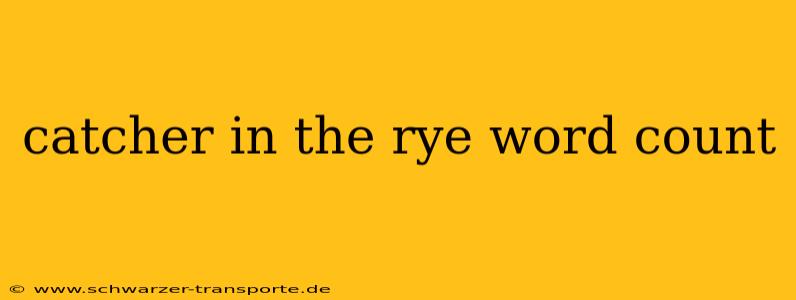Decoding the Word Count of The Catcher in the Rye and What It Means
The Catcher in the Rye, J.D. Salinger's iconic novel, has captivated and challenged readers for generations. But beyond its poignant coming-of-age story and Holden Caulfield's cynical narration, there's another aspect that often sparks curiosity: the word count. Understanding the word count of The Catcher in the Rye offers insight into its narrative structure and impact.
The Exact Word Count: A Moving Target
Pinning down the precise word count for The Catcher in the Rye proves surprisingly difficult. Different editions, digital versions, and even the original manuscript might vary slightly. However, a generally accepted range sits between 75,000 and 80,000 words. This is not an unusually long novel, falling comfortably within the range of many contemporary works of fiction. The perceived length is often more subjective and relates to the dense, conversational style of the narrative.
Why the Variation in Word Count Estimates?
The fluctuation in reported word counts arises from several factors:
- Different Editions: Minor edits, changes in formatting (punctuation, hyphenation), and even variations in typesetting can slightly affect the final word count.
- Digital vs. Print: Digital versions may employ different algorithms for word counting, leading to discrepancies.
- Inclusion of Epigraphs and Other Elements: Some editions include introductory material or epigraphs that aren't counted in every word count tally.
The Impact of the Novel's Length
Despite the relatively modest word count, The Catcher in the Rye feels longer due to several factors:
- Holden's Voice: Holden's rambling, often repetitive style and cynical tone creates a sense of immersion and intimacy. The reader feels as though they're directly experiencing Holden's thoughts and feelings in real-time, making the narrative feel longer and more immersive.
- Narrative Structure: The fragmented, non-linear storytelling structure contributes to the sense of length. The jumps in time and place keep the reader engaged, making the reading experience more engaging, if less chronologically efficient.
- Emotional Density: The book's emotional weight and the exploration of complex themes—alienation, grief, identity—contribute to the perception of length. Each scene carries a heavier emotional burden than might be found in other novels.
The Significance of the Narrative Style
The book's relatively concise length, combined with its potent narrative style, becomes a crucial element of its power. Salinger achieves an impressive level of emotional depth and character development within a manageable word count. The impact stems not merely from quantity but from the quality and intensity of Holden's voice and Salinger’s masterful control over the narrative's pacing. The story's relatively compact nature enhances the sense of immediacy and urgency surrounding Holden's experiences.
Conclusion: More Than Just Numbers
The word count of The Catcher in the Rye isn't simply a statistical measure. It's a reflection of Salinger's stylistic choices and a contributing factor to the novel's lasting impact. The narrative's efficiency and emotional intensity make it a powerful read despite (or perhaps because of) its relatively modest length. Its true power lies not in the number of words, but in the unforgettable experiences and emotions evoked within them.
